Great object. Really beautiful. Quick delivery. Excellent.
Zobacz tłumaczenieStarożytny Egipt Brązowy Fine Hathor staje twarzą w twarz z Lustrem. Okres późny, 664 - 332 p.n.e. Wysokość 28cm. Hiszpańska
Nr 88181217
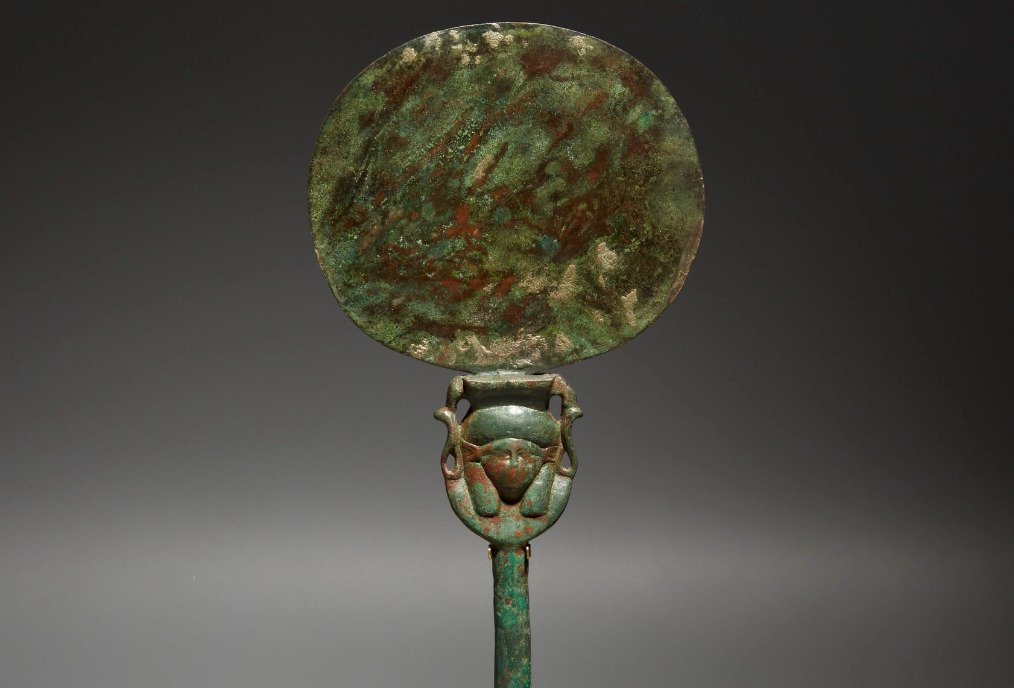
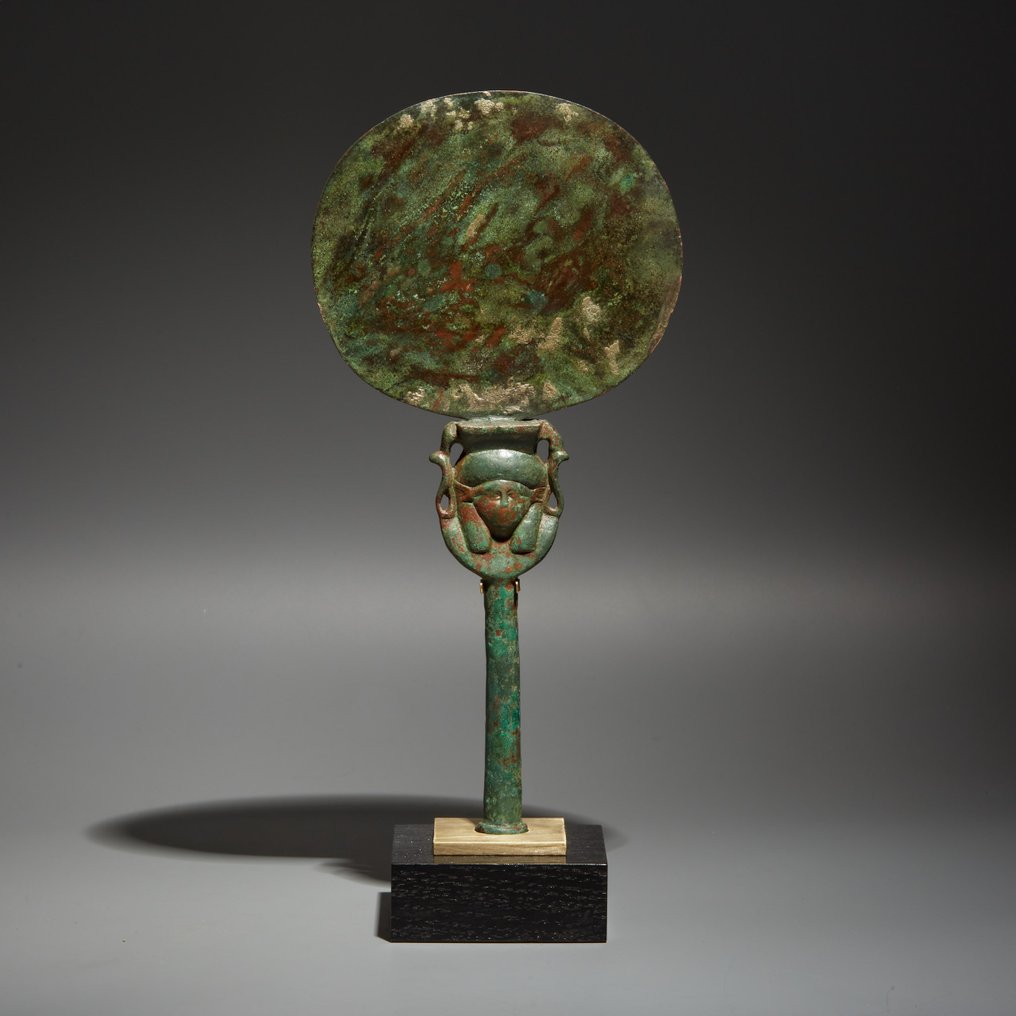
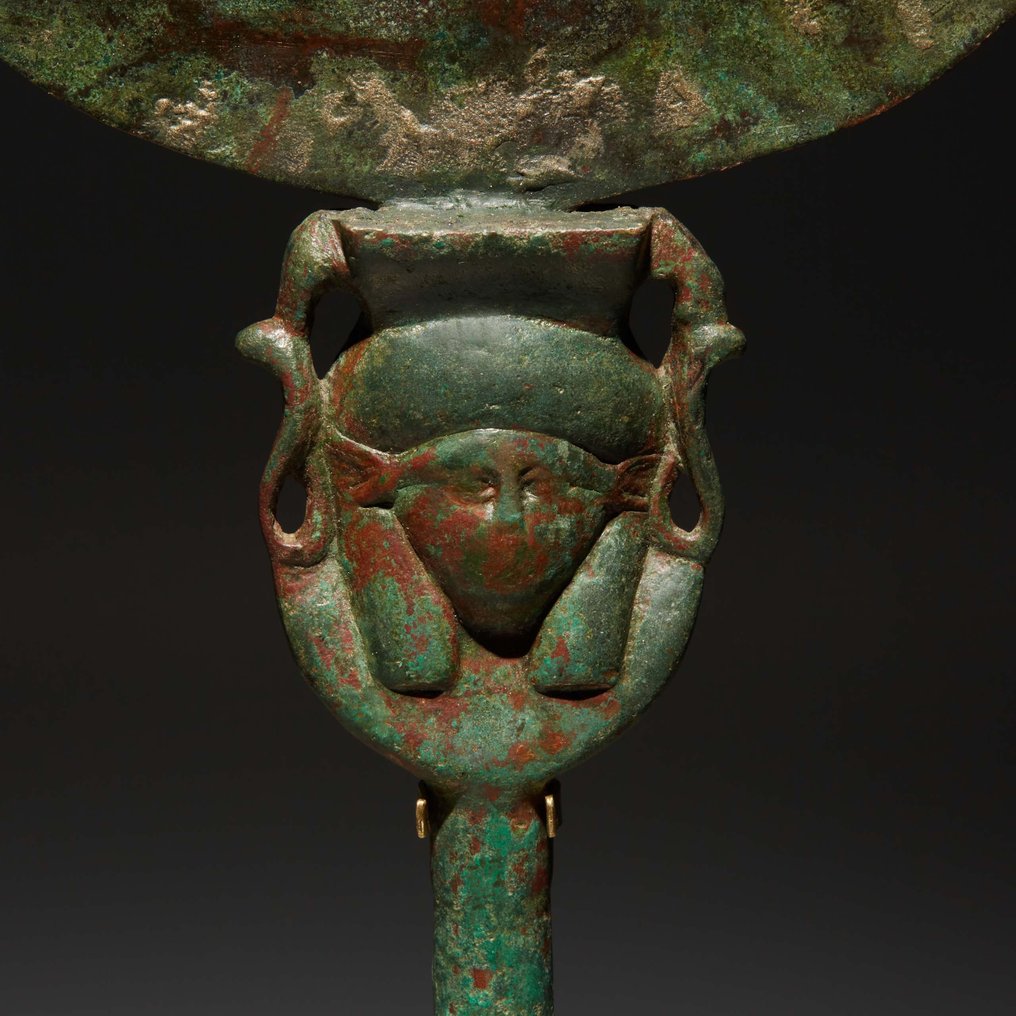
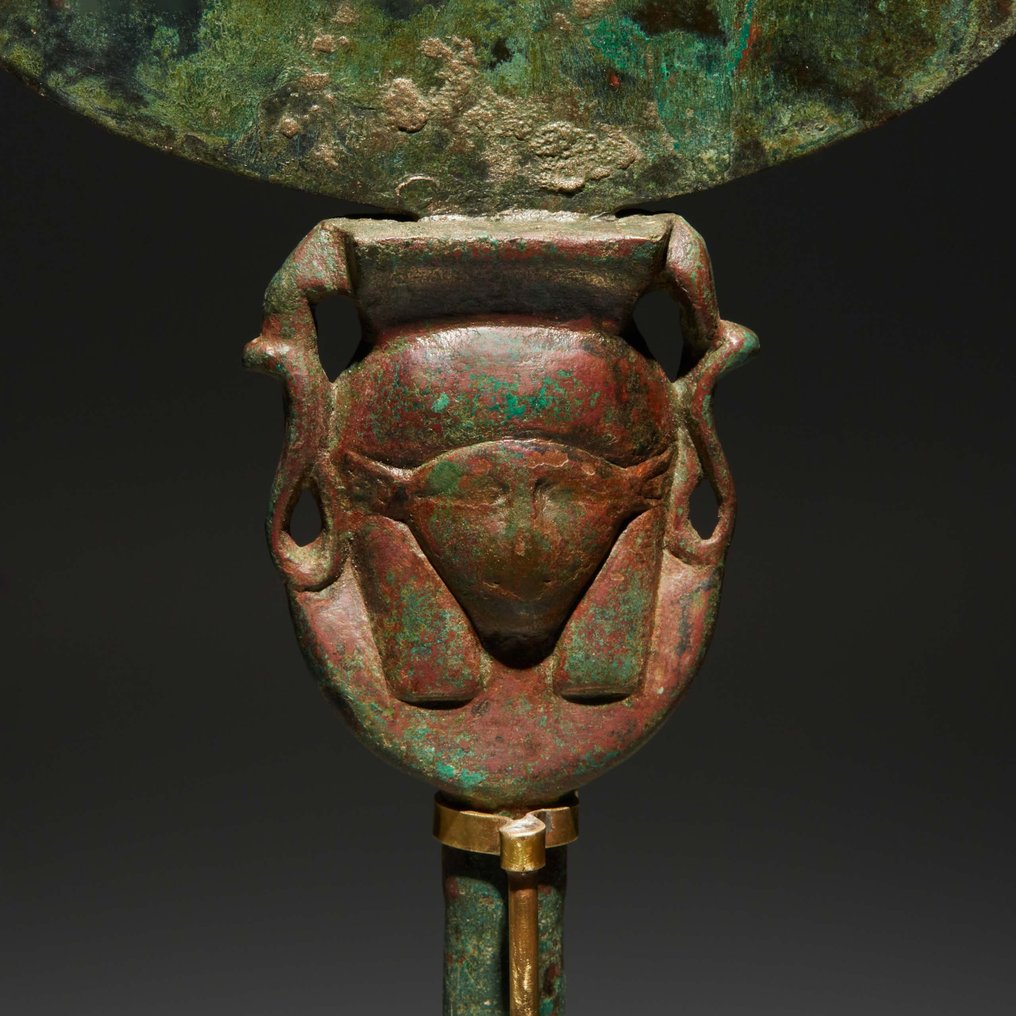
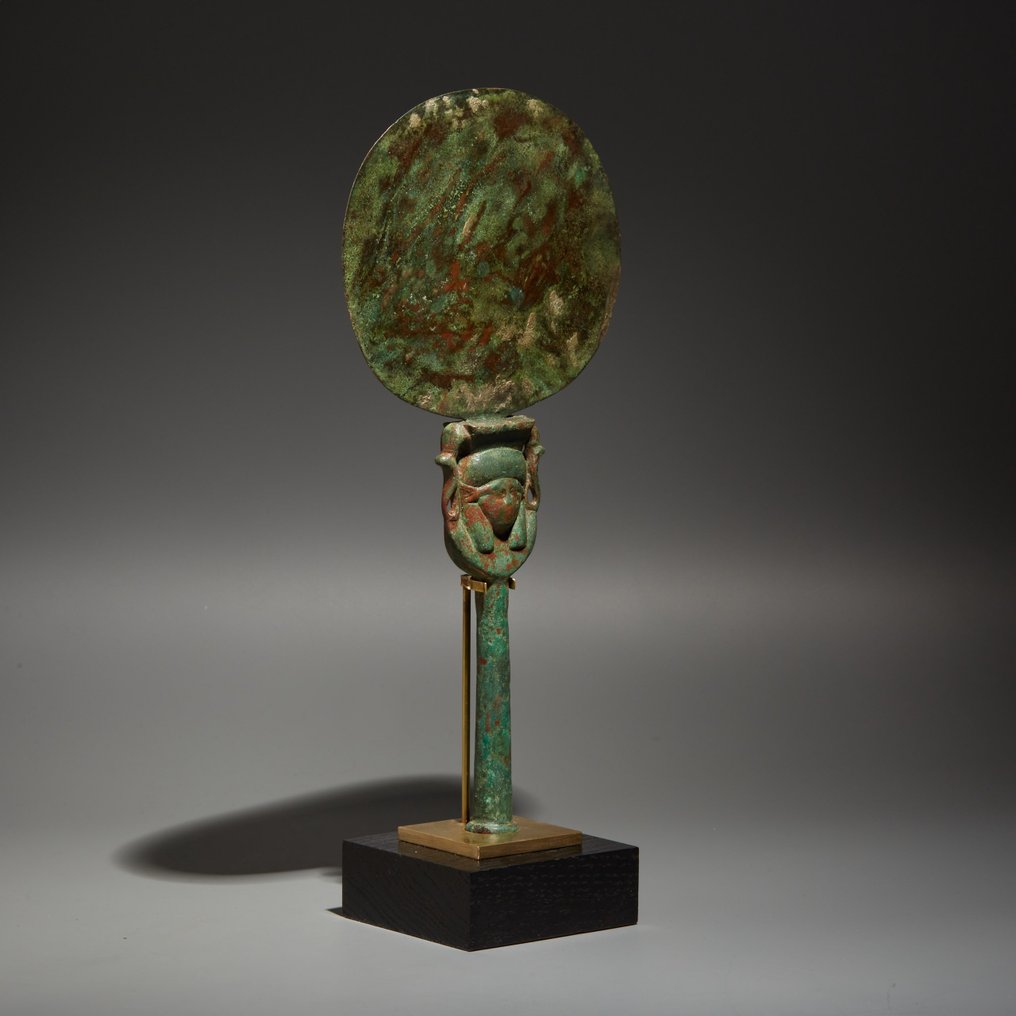
Mirror with hathor faces
- Important and Unique piece -
Ancient Egypt, Late Period, 664 - 332 BC.
Bronze.
Height 28 cm with out stand.
PROVENANCE: Private collection, Paris, France. Purchased from Maître Pajot, March 19, 1967, lot 11.
CONDITION: Good condition, it has wear on the surface of the face, especially on the nose.
DOCUMENTATION: Attached invoice from Maître Pajot, March 19, 1967, lot 11.
DESCRIPTION:
This beautiful example of an Egyptian mirror exhibits some interesting characteristics. Mirrors always occupied a dominant place among the so-called “dressing-table” accessories of Ancient Egypt. These Items, not only for women but also for men, were associated with the myths of the solar cycle.
The myth of the “distant goddess” tells how, the morning after the destruction of man which the lion goddess had carried out on the orders of the god Ra, she approached the flooded fields “to see her face beautifully reflected there”. Mirrors also referenced Shen ponds (which had the round form of the Shen ring) in the marshlands, where the goddess Hathor amused herself contemplating her own reflection, and thus forgetting in this manner her terrible desire to destroy humanity.
Egyptian mirrors, with their round shape referencing the solar disk, were objects known from the Middle Kingdom. The flat, round surface made of burnished metal enabled people to see their own countenance. Handles were generally in the form of the head of Hathor, or, as in this case, in a lotus or papyrus form. It was believed that by representing the goddess Hathor, goddess of love, an erotic value was given to the mirror. At the same time, the handle in the column form of the lotus flower or papyrus stem could be related to the meaning of its hieroglyphic, “green”, as a reference to rebirth. There are other connections that can be considered: the goddess Hathor is also associated with vegetation, papyrus marshes and stalks in particular, all elements that could be associated with the rebirth of the deceased. The shape of the mirror also evoked the image of the Ankh, the cross of life. In reflecting the image of the owner, it also produced the effect of vital regeneration so much desired by the ancient Egyptians. In sum, the mirror disk and the handle are both symbols associated with rebirth.
Hathor, in ancient Egyptian religion, goddess of the sky, of women, and of fertility and love. Hathor’s worship originated in early dynastic times (3rd millennium BCE). The name Hathor means “estate of Horus” and may not be her original name. Her principal animal form was that of a cow, and she was strongly associated with motherhood. Hathor was closely connected with the sun god Re of Heliopolis, whose “eye” or daughter she was said to be. In her cult centre at Dandarah in Upper Egypt, she was worshipped with Horus.
There were cults of Hathor in many towns in Egypt and also abroad, for she was the patroness of foreign parts and of many minerals won from the desert. In the Sinai turquoise mines, for example, she was called “Lady of Turquoise.” At Dayr al-Baḥrī, in the necropolis of Thebes, she became “Lady of the West” and patroness of the region of the dead. In the Late Period (1st millennium BCE), women aspired to be assimilated with Hathor in the next world, as men aspired to become Osiris. The Greeks identified Hathor with their Aphrodite.
Notes:
The seller guarantees that he acquired this piece according to all national and international laws related to the ownership of cultural property. Provenance statement seen by Catawiki.
The piece includes authenticity certificate.
The piece includes Spanish Export License (Passport for European Union) - If the piece is destined outside the European Union a substitution of the export permit should be requested. This process could take between 1 and 2 months.
#MasterpiecesW39
Historie sprzedawców
Mirror with hathor faces
- Important and Unique piece -
Ancient Egypt, Late Period, 664 - 332 BC.
Bronze.
Height 28 cm with out stand.
PROVENANCE: Private collection, Paris, France. Purchased from Maître Pajot, March 19, 1967, lot 11.
CONDITION: Good condition, it has wear on the surface of the face, especially on the nose.
DOCUMENTATION: Attached invoice from Maître Pajot, March 19, 1967, lot 11.
DESCRIPTION:
This beautiful example of an Egyptian mirror exhibits some interesting characteristics. Mirrors always occupied a dominant place among the so-called “dressing-table” accessories of Ancient Egypt. These Items, not only for women but also for men, were associated with the myths of the solar cycle.
The myth of the “distant goddess” tells how, the morning after the destruction of man which the lion goddess had carried out on the orders of the god Ra, she approached the flooded fields “to see her face beautifully reflected there”. Mirrors also referenced Shen ponds (which had the round form of the Shen ring) in the marshlands, where the goddess Hathor amused herself contemplating her own reflection, and thus forgetting in this manner her terrible desire to destroy humanity.
Egyptian mirrors, with their round shape referencing the solar disk, were objects known from the Middle Kingdom. The flat, round surface made of burnished metal enabled people to see their own countenance. Handles were generally in the form of the head of Hathor, or, as in this case, in a lotus or papyrus form. It was believed that by representing the goddess Hathor, goddess of love, an erotic value was given to the mirror. At the same time, the handle in the column form of the lotus flower or papyrus stem could be related to the meaning of its hieroglyphic, “green”, as a reference to rebirth. There are other connections that can be considered: the goddess Hathor is also associated with vegetation, papyrus marshes and stalks in particular, all elements that could be associated with the rebirth of the deceased. The shape of the mirror also evoked the image of the Ankh, the cross of life. In reflecting the image of the owner, it also produced the effect of vital regeneration so much desired by the ancient Egyptians. In sum, the mirror disk and the handle are both symbols associated with rebirth.
Hathor, in ancient Egyptian religion, goddess of the sky, of women, and of fertility and love. Hathor’s worship originated in early dynastic times (3rd millennium BCE). The name Hathor means “estate of Horus” and may not be her original name. Her principal animal form was that of a cow, and she was strongly associated with motherhood. Hathor was closely connected with the sun god Re of Heliopolis, whose “eye” or daughter she was said to be. In her cult centre at Dandarah in Upper Egypt, she was worshipped with Horus.
There were cults of Hathor in many towns in Egypt and also abroad, for she was the patroness of foreign parts and of many minerals won from the desert. In the Sinai turquoise mines, for example, she was called “Lady of Turquoise.” At Dayr al-Baḥrī, in the necropolis of Thebes, she became “Lady of the West” and patroness of the region of the dead. In the Late Period (1st millennium BCE), women aspired to be assimilated with Hathor in the next world, as men aspired to become Osiris. The Greeks identified Hathor with their Aphrodite.
Notes:
The seller guarantees that he acquired this piece according to all national and international laws related to the ownership of cultural property. Provenance statement seen by Catawiki.
The piece includes authenticity certificate.
The piece includes Spanish Export License (Passport for European Union) - If the piece is destined outside the European Union a substitution of the export permit should be requested. This process could take between 1 and 2 months.
#MasterpiecesW39
Historie sprzedawców
- 823
- 11
- 1
Superbe objet, Service d'Arqueologia Ancient Art excellent et rapide. Jaume Bagot toujours parfait .
Zobacz tłumaczenieTodo perfecto gracias
Zobacz tłumaczenieNice item all ok A+++
Zobacz tłumaczenieThank you for this Oinochoe, one question: did you as promised read my post!
Zobacz tłumaczenieExcellent translation, and very prompt delivery. Imperfect packaging. A significant crack of the board that had not been described in the original post of the item.
Zobacz tłumaczenieAlways a great pleasure!
Zobacz tłumaczenieFine quality, good service. Thanks.
Zobacz tłumaczenieMuy amables, muy bien todo. Gracias
Zobacz tłumaczenieAlles bestens
Zobacz tłumaczenieexactly as described and shipped safely and punctually.
Zobacz tłumaczenieschnelle Lieferung sehr sichere Verpackung alles bestens
Zobacz tłumaczenietres bel objet je le recherchai depuis longtemps envoi rapide et protégé je pense qu'il y aura d'autres achats avec ce vendeur merci +++++++
Zobacz tłumaczenieEinfach nur toll
Zobacz tłumaczenieTodo perfecto
Zobacz tłumaczenieottimo
Zobacz tłumaczenieperfetto
Zobacz tłumaczenietop oggetto bellissimo grazie 💯💯💯💯💯💯 :-)
Zobacz tłumaczenieI bought this beautiful artifact together with artifact from Mr. Bagot but although it is clearly stated on his shipping page that when purchasing multiple artifacts i paid the double package costs
Zobacz tłumaczenieI bought this beautiful artifact together with artifact from Mr. Bagot but although it is clearly stated on his shipping page that when purchasing multiple artifacts i paid the double package costs
Zobacz tłumaczenieBel objet, bien emballé. Parfait.
Zobacz tłumaczeniewonderful faiece and very fast shipping.thanks a lot
Zobacz tłumaczenieJ Bagot es un profesional excelente. Sus artículos son de gran calidad, se incluye la documentación necesaria y el embalaje se realiza con esmero. Le recomiendo encarecidamente.
Zobacz tłumaczenieo envio foi bastante rápido, obrigado.
Zobacz tłumaczenieSono molto soddisfatto grazie.
Zobacz tłumaczenie- 823
- 11
- 1
Great object. Really beautiful. Quick delivery. Excellent.
Zobacz tłumaczenieKlauzula
Sprzedawca gwarantuje i może udowodnić, że przedmiot został nabyty legalnie. Sprzedawca został poinformowany przez firmę Catawiki, że musi dostarczyć dokumentację wymaganą przez przepisy ustawowe i wykonawcze obowiązujące w jego kraju zamieszkania. Sprzedawca gwarantuje i jest uprawniony do sprzedaży/eksportu tego przedmiotu. Sprzedawca przekaże nabywcy wszystkie znane informacje o pochodzeniu przedmiotu. Sprzedawca zapewnia, że wszelkie niezbędne pozwolenia są/zostaną załatwione. Sprzedawca niezwłocznie poinformuje nabywcę o wszelkich opóźnieniach w uzyskaniu takich zezwoleń.
Sprzedawca gwarantuje i może udowodnić, że przedmiot został nabyty legalnie. Sprzedawca został poinformowany przez firmę Catawiki, że musi dostarczyć dokumentację wymaganą przez przepisy ustawowe i wykonawcze obowiązujące w jego kraju zamieszkania. Sprzedawca gwarantuje i jest uprawniony do sprzedaży/eksportu tego przedmiotu. Sprzedawca przekaże nabywcy wszystkie znane informacje o pochodzeniu przedmiotu. Sprzedawca zapewnia, że wszelkie niezbędne pozwolenia są/zostaną załatwione. Sprzedawca niezwłocznie poinformuje nabywcę o wszelkich opóźnieniach w uzyskaniu takich zezwoleń.









